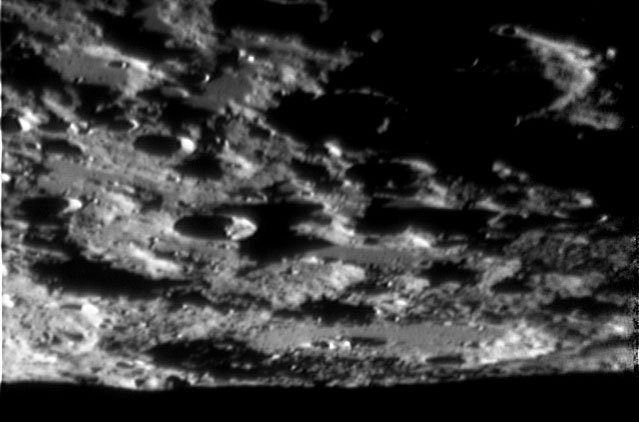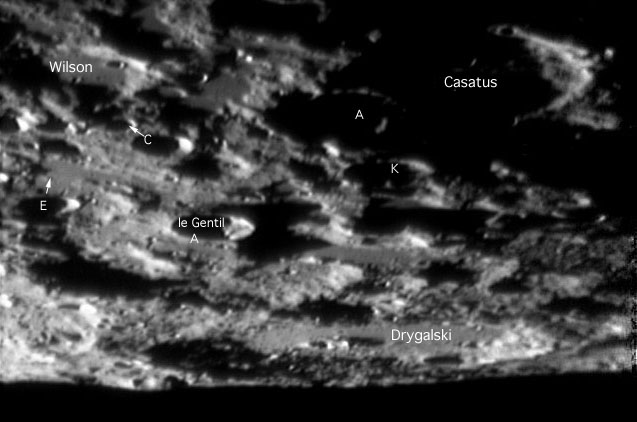Difference between revisions of "October 12, 2004"
| (6 intermediate revisions by the same user not shown) | |||
| Line 1: | Line 1: | ||
__NOTOC__ | __NOTOC__ | ||
=Polar Dryness= | =Polar Dryness= | ||
| + | <!-- Start of content --> | ||
<table width="85%" border="0" align="center" cellpadding="6" cellspacing="2"> | <table width="85%" border="0" align="center" cellpadding="6" cellspacing="2"> | ||
<tr> | <tr> | ||
| Line 13: | Line 14: | ||
</table> | </table> | ||
<table width="80%" border="0" align="center" cellpadding="8"> | <table width="80%" border="0" align="center" cellpadding="8"> | ||
| − | <tr><td><div align="center" class="main_sm">Image Credit: [mailto:tbash@ptd.net Tom Bash ]</p> | + | <tr><td><div align="center" class="main_sm"><p>Image Credit: [mailto:tbash@ptd.net Tom Bash ]</p> |
</div></td> | </div></td> | ||
</tr> | </tr> | ||
| Line 26: | Line 27: | ||
October 8, 2004, 9:46 UT. C9.25 + ToUcam web cam, utilizing a 2X barlow</p> | October 8, 2004, 9:46 UT. C9.25 + ToUcam web cam, utilizing a 2X barlow</p> | ||
<p><b>Related Links:</b><br> | <p><b>Related Links:</b><br> | ||
| − | [ | + | [http://www.lpi.usra.edu/research/lunar_orbiter/images/img/iv_193_h1.jpg Lunar Orbiter IV View ] |
<br>Rukl <i>Atlas of the Moon</i> Sheets 72 & VI | <br>Rukl <i>Atlas of the Moon</i> Sheets 72 & VI | ||
<br>[http://www.lpi.usra.edu/meetings/LPSC99/pdf/1343.pdf Aqueous Alteration on the Moon] | <br>[http://www.lpi.usra.edu/meetings/LPSC99/pdf/1343.pdf Aqueous Alteration on the Moon] | ||
</p> | </p> | ||
| − | <p | + | <p><b>Yesterday's LPOD:</b> [[October 11, 2004|Fertility Central]] </p> |
| + | <p><b>Tomorrow's LPOD:</b> [[October 13, 2004|Gasping at Gassendi]] </p> | ||
</tr> | </tr> | ||
</table> | </table> | ||
| Line 41: | Line 43: | ||
<p align="center" class="main_titles"><b>Author & Editor:</b><br> | <p align="center" class="main_titles"><b>Author & Editor:</b><br> | ||
[mailto:tychocrater@yahoo.com Charles A. Wood]</p> | [mailto:tychocrater@yahoo.com Charles A. Wood]</p> | ||
| − | < | + | <!-- Cleanup of credits --> |
| − | + | <!-- Cleanup of credits --> | |
| − | < | + | <!-- Cleanup of credits --> |
| − | + | <!-- Cleanup of credits --> | |
| − | + | <!-- Cleanup of credits --> | |
| − | < | + | <!-- Cleanup of credits --> |
| − | < | + | <!-- Cleanup of credits --> |
| − | + | <!-- Cleanup of credits --> | |
| − | < | + | <!-- Cleanup of credits --> |
| − | + | <!-- Cleanup of credits --> | |
</td></tr> | </td></tr> | ||
</table> | </table> | ||
<p> </p> | <p> </p> | ||
| − | ---- | + | <!-- End of content --> |
| − | + | {{wiki/ArticleFooter}} | |
| − | |||
Latest revision as of 14:00, 15 March 2015
Polar Dryness
Image Credit: Tom Bash |
|
Polar Dryness The lunar south polar region almost always presents a craggy wilderness of rims and peaks, all squeezed together by foreshortening and exaggerated by grazing lighting. Its a delightful place to observe and maybe someday to visit. Many of the craters, even though actually on the Earth-facing hemisphere can only be clearly seen when librations are favorable, as when Tom Bash took this great view of Drygalski at 87 degrees W and 80 degrees S. With a diameter of 163 km Drygalski would be a dominating crater if it were further from the limb. Drygalski is a Copernicus-like crater, with flat floor, terraced walls and a large central peak. The crater is relatively old, and is cut by secondary impact craters from the formation of the younger crater Hausen. The flat floor was probably originally covered with impact melt, but may also have received fluidized ejecta from the formation of the Orientale impact basin. Drygalski is not within the permanently shadowed part of the south pole but spectral evidence of the water-bearing minerals called phyllosilicates were detected in the walls of Drygalski, Klaproth and a few other craters. I am concerned that the same technique also identified phyllosilicates in the walls of Clavius (49 degrees S), which is far from the pole! Technical Details: Related Links: Yesterday's LPOD: Fertility Central Tomorrow's LPOD: Gasping at Gassendi |
|
Author & Editor: |
COMMENTS?
Register, Log in, and join in the comments.





